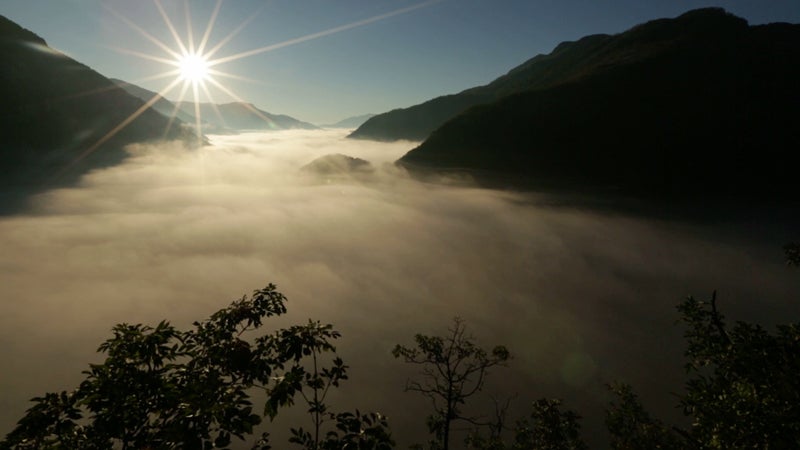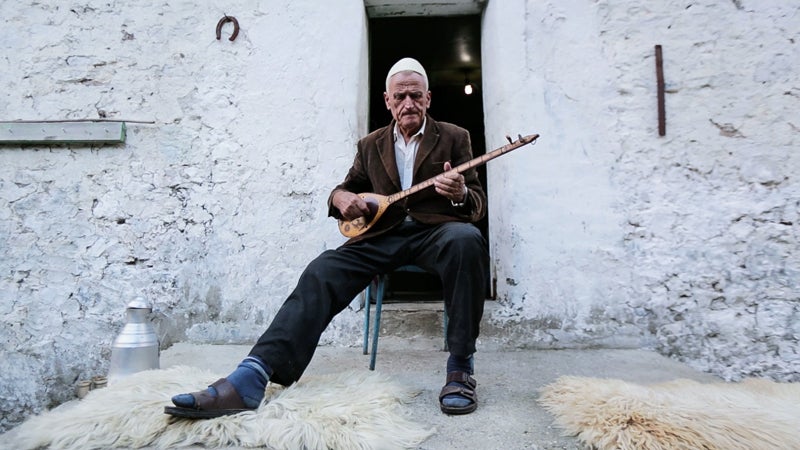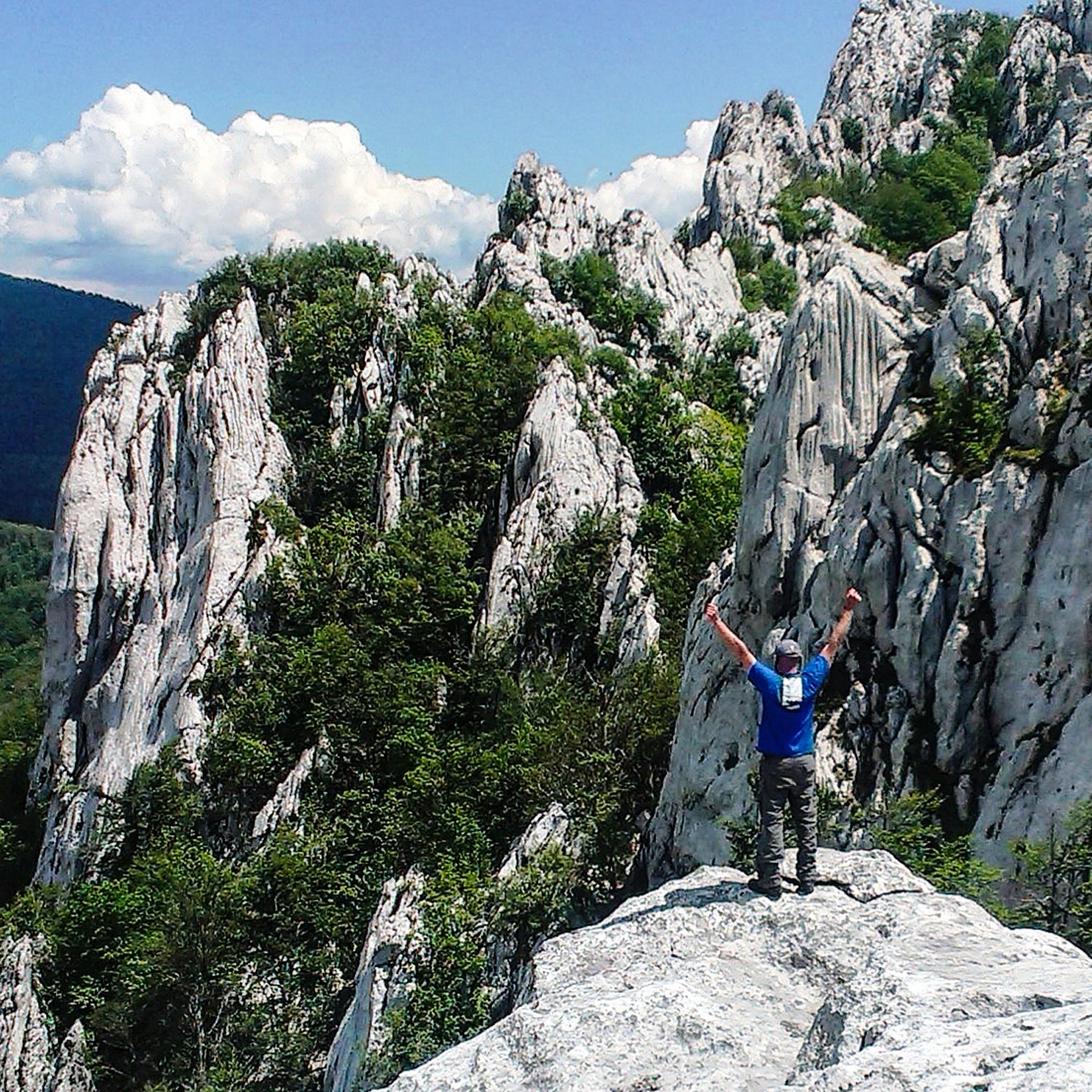Heavy storms and a 100-year flood battered the Balkans in May, but by the end of the month, the sun appeared and I was bound for Slovenia and the northern head of the new Via Dinarica hiking trail, which follows the Dinaric Alps, a 620-mile string of peaks spilling south and east from the Alps proper.
My goal: to walk several sections of the route, which, like the range, parallels the Adriatic Sea and connects countries down the length of the Balkan Peninsula. The main artery of the Via Dinarica—named Outside’s Best New Trail for 2014—is called the White Trail. It crosses, in geographic order, Slovenia, Croatia, Bosnia and Herzegovina, Montenegro, Albania, and Kosovo.

For countries along the Via Dinarica, the hope is that this megatrail corridor—a project funded by the European Union, the United Nations Development Programme, and the U.S. Agency for International Development—will eventually showcase an underutilized mountain range to a global audience. The route would act as a vehicle to highlight the breadth of the region’s outdoor adventure possibilities and often-overlooked Old World culture and promote environmental awareness. With any luck, it could also ignite and galvanize camaraderie among the range’s historically contentious neighbors.
“Connecting the dots, combining resources and offers, and sharing a common visual identity will help put the Via Dinarica on the outdoor traveler’s radar,” Tim Clancy, media consultant for the project, wrote in an email. “It will provide sustainable incomes for mountain folks as well as youth (where unemployment is as high as 60 percent in many places), and it will force governments’ hands in establishing better channels of cross-border communication and cooperation because of tourism, border-crossing issues, and branding.”
But with all that the Western Balkans countries have endured the past 20 years—hell, the past 500 years—imagining that a trail could act as a tourism engine while also loosening the grip and memory of dictatorships, cross-border wars in the former Yugoslavia, and intolerant fate seems, at the start of our journey, mighty ambitious. The plan does possess one giant trump card: Few acts are as simple, straightforward, beautiful, and universal as a hike in the mountains. For visitors such as myself, this is the brand-spanking-new Via Dinarica’s hopeful, peaceful plea.
Driving through western Bosnia, however, nothing appeared brand spanking new. Old men in coveralls and women with kerchiefs scored black soil with hoes that looked as if they’d been handed down since the Habsburgs. A horse pulling a red wooden carriage filled with hay loped past the occasional burned-out building—souvenirs from the 1990s Yugoslav conflict. Villages were demarcated by symbols devoted to higher powers. The call to prayer, bellowing from a mosque’s minaret, gave way to clover-shaped Orthodox crosses, which morphed into Catholic churches taking shape on the next horizon. Everywhere, axes splitting wood paced the drive with a discordant, metronomic orchestra.
As we drove north, the two-month, six-part journey became real. My trek will begin in karst- and cave-filled Slovenia. Afterward, I will hike through Croatia, which, like Slovenia, is a member of the European Union. Known more for its coast, Croatia possesses a jagged relief of dramatic mountains, including the trail’s namesake: Mount Dinara. Some of the most epic hiking will take place across Bosnia and Herzegovina’s virgin forests and sweeping, untouched vistas.
Then, I’ll take part in a 500-kilometer bicycle ride across Bosnia to commemorate the anniversary of the Srebrenica massacre in 1995. Next, I move into Montenegro to experience the Tara Canyon, the deepest river canyon in Europe, and Durmitor National Park, a UNESCO World Heritage site. Finally, I will hike into Albania, home to the rugged Prokletije Mountains and the 8,839-foot Maja Jezerce. I’ll end in Kosovo, one of the world’s newest countries and outdoor-adventure destinations.


During each stage, I will travel with a different cast of vagabonds—mountaineers, outdoor enthusiasts, and climbers—who will hike and bike with me and provide local expertise. The exception will be a Dutchman named Thierry Joubert, a friend and mountain guide with a these-aren’t-the-droids-you’re-looking-for demeanor, who runs the Bosnian-based eco-adventure outfitter Green Visions. Thierry has lived in the region for 22 years and will be my partner in crime throughout the journey.
“The tagline of the Via Dinarica is ‘connecting naturally,’” Thierry said from the driver’s seat, resuming a sentence he’d started before he handed his passport to the border patrol officer. “But what the trail actually does is reconnect people across the Balkans from Slovenia to Albania.”
Though we won’t walk the path step for step, we will be pioneers of sorts. (Most expeditions will be about a week long, and we will occasionally use transfers along the way, due to time constraints.) The nascent trail, fully actualized conceptually, still lacks much in the way of signage, maps, and publicity—even here in the Balkans. Mountain associations along the route have started to jump on board, but for many locals the term Via Dinarica is as foreign as my mama’s homemade apple pie.
The part that won’t be foreign about the Via Dinarica for experienced through-hikers familiar with European trails: the rush of trekking from summit to summit, from hut to hut, from village to village. The difference for those who have hiked in Western Europe: This trail has some polishing yet to do. For folks who like to discover places while they’re still wet-paint-fresh, the time is right for a trans-Balkan jaunt.
I’ve hiked multicountry European megatrails before. In 2007, I walked from Trieste, Italy, up and over the Alps to Monaco on the well-groomed and tourist-heavy Via Alpina. Connecting eight nations, the Via Alpina was the inspiration for the Via Dinarica, which started to take shape on paper in 2010. The skeletal frame for the Via Dinarica, in the process of being fully marked, combines long-standing hiking paths, shepherds’ tracks, smugglers’ routes, and former World War II military trails carved by partisan soldiers while outmaneuvering Nazi regiments.
The populations spread across the Via Dinarica speak three distinct languages and observe four religions. Their histories were molded by the Great Schism between the Eastern and Western churches in 1054. Their empires were carved up by the Habsburgs, the Ottomans, and the Venetians. Their alliances are ancient. Their rifts are current.
Though the countries of the Balkans have a long history of mountaineering, for the most part people here don’t consider hiking a birthright like those in France or Switzerland might. With the exception of Slovenia and to a lesser degree Croatia, mountain huts aren’t evenly spaced the way they are in Western Europe. Trekking here can be untamed at times. Trail markings can be inconclusive. Maps are precious. Advice from locals and shepherds is even more so. A local human guide’s consultation is often necessary. If one gets lost, it could be for a while. Worst-case scenario: You end up in a Balkan village and take up residence. Best-case scenario: You find a Balkan wife and learn obedience.
“The Via Dinarica is challenging from a sport perspective,” continues mountaineer Kenan Muftić, who was the trail’s project manager during its original planning stages. “But it is removed, and the conditions aren’t perfect like in other places. And,” he looked at me with a mischievous glint in his eye, “it’s wild.”

The reasons for that wildness are manifold. Some explanations are theoretical, and some are concrete. Theoretically, this isn’t Western Europe. People here are tough. Rare is the generation that hasn’t known hardship of the sort that most living Americans will hopefully never see. My people are from here (my paternal grandfather emigrated to the States), but by every definition I am a delicate flower in comparison.
More concretely, the great outdoors here are, by design, less developed. Massive swaths of the region are unsullied, unindustrialized, and nearly untouched. There are primordial forests. For decades, this region has bucked modernity—through communism and conflict—in an unwitting quest to remain one of the last wild places in Europe. Locals make their own cheese, concoct their own brandy (called rakija), and cook coffee on ancient iron stoves. Shepherds still wander remote hilltops and along craggy mountaintops. Hidden rivers, canyons, and lakes pop up from behind peaks as if a director had moments before called out, “Places!”
And then there’s the war. Folks here—including frequent tourists like me—are desperate to get past the war. At best, the subject is boring for locals. At worst, the fear is that by focusing on the war that splintered Yugoslavia between 1991 and 1995, visitors will continue to focus on the war. I won’t go too far down this rabbit hole then, except to say two things. First, the war was devastating in every way a war can be: physically, psychologically, governmentally, and economically. Second, tourists are absolutely safe here. Full stop.
For the purposes of the Via Dinarica, the war had another, unexpected effect. Especially in Bosnia, the war changed the mountains conceptually. For many, mountains still represent the frontlines during the four-year conflict in the mid-1990s. Armies lobbed mortars into cities from peaks and ridges. Hilltop snipers aimed at children scurrying through streets carrying water.
“A generation of fathers and grandfathers stopped taking their kids into the mountains,” says Samer Hajrić, a Bosnian mountain guide, who was in our SUV on the way to Slovenia. “There is a gap in the tradition.”
And there are the landmines. Landmines are a big problem, especially in Bosnia, which was supposed to be mine-free by 2009. According to Bosnia and Herzegovina’s Mine Action Center, mines still cover 2.4 percent of the country, and their complete removal is now projected for 2019. However, safety concerns for trekkers are minimal. Most mine-risk areas are clearly marked. The rule here is “if you don’t know, don’t go.” Translation: If you aren’t absolutely sure about where you’re about to hike, get a guide. You’ll learn more about the trail and the culture, and the price, relative to the United States, is cheap.
Sound like a lot to digest before a hike in the mountains? It is. The Balkan Peninsula is a beautifully complicated place. Readers should think less about trekking here in terms of reaching lung-busting elevations and more from the perspective of achieving personal-best cultural interactions.
After leaving Sarajevo, we had one goal on our first day: get to the Postojnska Jama in Slovenia, the self-proclaimed “best-known cave in the world.” An admittedly tourism-heavy affair, the entrance to Postojna’s 21 kilometers of labyrinthine underground passages is a giant Secessionist-era manor with an apron of cafes, fast-food eateries, and trinket shops. The spot is, however, emblematic of the karst substrate that will cover much of my hike through the Balkan Peninsula’s western half.
We arrived late in the day and zoomed through the cave on a train moving at a speed that could only be the result of a driver ready to go home to dinner with his wife. We whisked past the stalactites and stalagmites that are indicative of the subterranean level here. Much of Slovenia, Croatia, and Bosnia is riddled with such caves—porous limestone carved by underground rivers—making it one of the largest karst fields on the planet.
The next day, we set off on the first of three days of hiking. We met up with Jernej Jež, a Slovene geologist working with the Geological Survey of Slovenia, appropriately, and a member of the nearby Mountaineering Club Podnanos. As we hiked to Veliki Snežnik, the highest peak in the region at 1,796 meters (5,892 feet), Jež explained that the Dinaric Alps, composed of carbonate rocks, were formed after the Adria microplate plate, moving north and east, collided with the European plate and was tucked underneath. He moved his hands to display a thrusting and folding motion as if he were making an invisible crust-and-mantle Dagwood sandwich.
We walked to the summit of Snežnik Mountain, strewn with patches of grass covering pocked limestone like bad teeth under an unkempt beard. We looked across the southern frontier of Slovenia, often called Little Switzerland. Jež stopped making his earthen hoagie and swung an arm, pointing in the near distance with Vanna White–like grace: “That is Croatia.”

Coming down from the mountain, we walked past World War I bunkers and tank traps built to protect the border. A mama brown bear saw us and hurried her two cubs over the next ridge. “The Via Dinarica is a perfect plan,” Jež said a few kilometers later when we reached Sviščaki, the next mountain hut. We ordered beer. After a mandatory discussion with the hut’s owner about which of Slovenia’s main beers is better, Union or Laško, Jež continued, “It connects places with similar geographies and different cultures. With different but also the same histories.”
After leaving Jež, we debated our next move. We had originally planned to walk across the border to Croatia, but hiking through countries with relatively new political realities is a logistical challenge. Though both Slovenia and Croatia are EU members, the latter has yet to be admitted in the Schengen Area: a border-free zone that, according to the European Commission’s website, “guarantees free movement to more than 400 million EU citizens.” Rather than risk a large fine and the administrative headache of getting caught illegally crossing the border, we drove through passport control. (Croatia was admitted into the EU in 2013. Rumor is that it will be admitted into the Schengen Area in 2015.)
At around 11 p.m., after a teeth-shattering four-wheel-drive crawl that locals passionately warned us to avoid, we entered the Planinarski dom (mountain hut) Hahlić. We sat with Romina Vidrih, who, with two other families, runs the hut for a mountain association that boasts 200 members. The renovated, meticulously clean hut sleeps 40 and sits in the middle of 10 peaks—all a day hike away. Though Vidrih was a seasoned hiker and had bagged many of the summits I was planning over the next two months, she had not heard of the Via Dinarica.
The next morning, we took one of the day hikes to the nearby Obruč peak before setting off west to Risnjak, the northernmost of Croatia’s eight national parks. Designated a national park in 1953, Risnjak covers more than 24 square miles and forms a synapse between the coast and the continent. As we stared across the unmolested, undulating forested terrain, it became obvious how important protecting sensitive chunks of real estate can be, even—perhaps especially—in a small country about the size of West Virginia. The park provides habitat for more than 1,000 different plants, as well as wolves, bears, and lynx.
It’s a nine-hour hike from the Hahlić through the Platak ski center, across Snježnik—a peak inside the park’s western edge—to the Schlosser mountain hut, which sits just below the Risnjak’s highest point, the 1,528-meter (5,013 feet) Veliki Risnjak. While dining on bowls of polenta-and-beef goulash, we spoke with the proprietor Gari Devčić, who was, he proudly announced, named after Gary Cooper. Every day, Gari treks in daily supplies for the hut, recognized in 2013 as Croatia’s best.
“The Via Dinarica is a fantastic idea. We will build a new Yugoslavia,” Gari said and laughed. “It will be great for mountaineering all over the region. We need many more people to come walk around the mountains for us to stay open.”
We woke at five the next morning to summit Veliki Risnjak. From the peak, we—two Bosnians, a Croatian, a Dutchman, and an American—could see the sun rising over Western Europe. Behind us, the light inched across the park and began to illuminate the coast. “It is easy to feel small, isn’t it?” Thierry asked rhetorically as he turned around to watch the Istrian Peninsula and Croatia’s northernmost islands, Cres and Krk, take shape in the dawn mist. Behind them, our next stage: a hike from Croatia’s Velebit Mountains to Paklenica National Park, famous for its climbing above the Adriatic Sea. “Past those waves, the mountains are waiting for us. We have a long way to go to get to Albania.”

